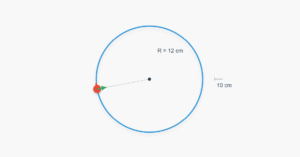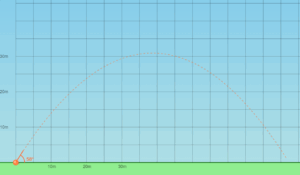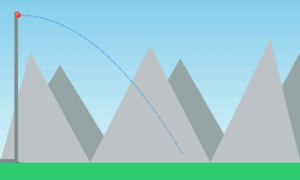Particle Motion with Constant Acceleration
Example 4.5: Motion in x-y plane with constant acceleration
Example
Question:
A particle starts from the origin at \(t = 0\) with velocity \(5.0\,\hat{\imath}\,\mathrm{m/s}\) and moves in the \(xy\)-plane under a constant acceleration of \((3.0\,\hat{\imath} + 2.0\,\hat{\jmath})\,\mathrm{m/s^2}\).
(a) What is the \(y\)-coordinate of the particle at the instant its \(x\)-coordinate is \(84\,\mathrm{m}\)?
(b) What is the speed of the particle at this time?
Solution:
From Eq. (3.34a) (with \(r_0 = 0\)), the position is \[ \vec{r}(t) = \vec{v}_0 t + \frac{1}{2}\vec{a}t^2 = 5.0\,t\,\hat{\imath} + \frac{1}{2}(3.0\,\hat{\imath} + 2.0\,\hat{\jmath})t^2 \] \[ = (5.0 t + 1.5 t^2)\, \hat{\imath} + (1.0 t^2)\, \hat{\jmath} \] Thus, \[ x(t) = 5.0 t + 1.5 t^2 \] \[ y(t) = 1.0 t^2 \] Set \(x(t) = 84\,\mathrm{m}\): \[ 5.0 t + 1.5 t^2 = 84 \implies t = 6\,s \] Then, \[ y = 1.0 \times (6)^2 = 36.0\,\mathrm{m} \] The velocity is \[ \vec{v} = \frac{d\vec{r}}{dt} = (5.0 + 3.0 t)\, \hat{\imath} + 2.0 t\, \hat{\jmath} \] At \(t = 6\,s\): \[ \vec{v} = (5.0 + 3.0 \times 6)\, \hat{\imath} + (2.0 \times 6)\, \hat{\jmath} = 23.0\,\hat{\imath} + 12.0\,\hat{\jmath} \] Speed: \[ |\vec{v}| = \sqrt{23.0^2 + 12.0^2} \approx 26\,\mathrm{m/s} \]
Results at t = 0.0 s:
Position: (0.0 m, 0.0 m)
Velocity: (5.0 m/s, 0.0 m/s)
Speed: 5.0 m/s
Physics Explanation:
This simulation demonstrates the motion of a particle with initial velocity and constant acceleration in the x-y plane.
Given:
- Initial velocity: \( \mathbf{v}_0 = 5.0 \hat{\mathbf{i}} \, \text{m/s} \)
- Constant acceleration: \( \mathbf{a} = (3.0 \hat{\mathbf{i}} + 2.0 \hat{\mathbf{j}}) \, \text{m/s}^2 \)
Position as function of time:
\[ \mathbf{r}(t) = \mathbf{v}_0 t + \frac{1}{2} \mathbf{a} t^2 \]
\[ x(t) = 5.0 t + 1.5 t^2 \]
\[ y(t) = 1.0 t^2 \]
Velocity as function of time:
\[ \mathbf{v}(t) = \frac{d\mathbf{r}}{dt} = (5.0 + 3.0 t) \hat{\mathbf{i}} + 2.0 t \hat{\mathbf{j}} \]
Textbook Questions:
(a) When x = 84 m:
\[ 5.0 t + 1.5 t^2 = 84 \Rightarrow t = 6 \, \text{s} \]
\[ y(6) = 1.0 \times 6^2 = 36.0 \, \text{m} \]
(b) Speed at t = 6 s:
\[ \mathbf{v}(6) = 23.0 \hat{\mathbf{i}} + 12.0 \hat{\mathbf{j}} \, \text{m/s} \]
\[ \text{Speed} = \sqrt{23^2 + 12^2} \approx 26 \, \text{m/s} \]



